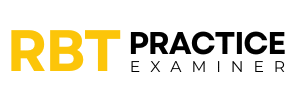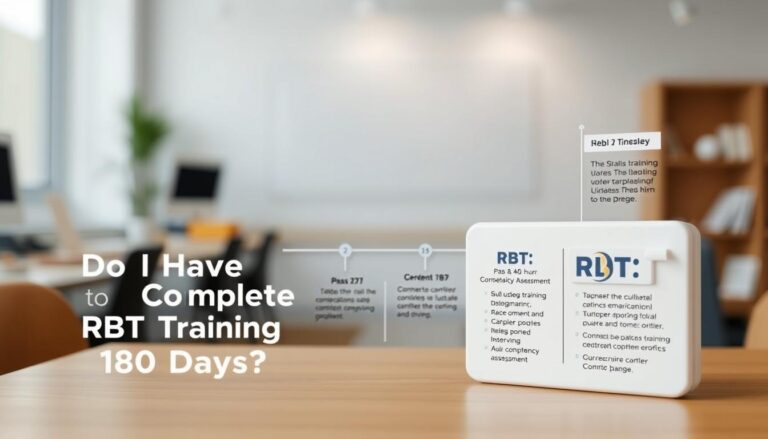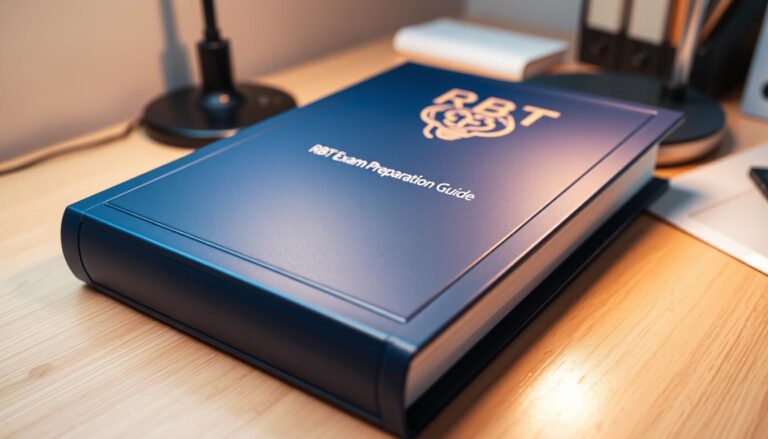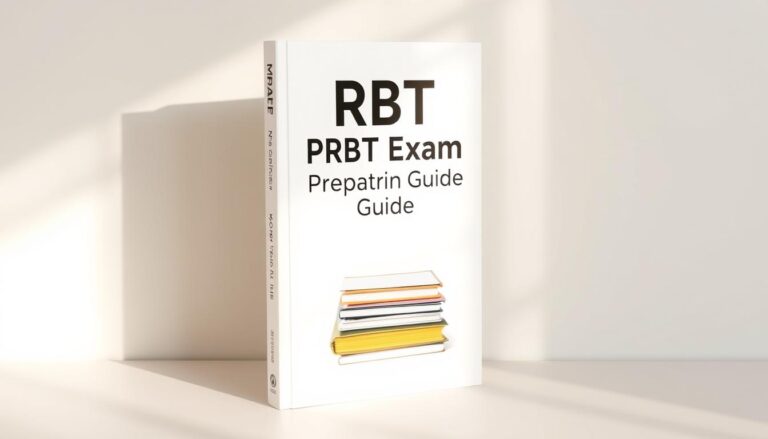10 Powerful Tips to Become a Better RBT Today!
To be a top-notch Registered Behavior Technician (RBT), you need to keep learning and growing. This job is all about making a big difference in people’s lives. It’s not just about the work; it’s about the passion you bring to it.
Being a great RBT is more than just knowing the basics. It’s about having a mix of skills and care. We’ll show you ten key ways to boost your training and do better in your job.
Good RBTs know they’re always learning and growing. We’ll share tips to make you better at your job. You’ll learn how to improve your skills, talk to clients better, and start a fulfilling career in behavior analysis.
These tips cover everything from collecting data to talking to clients. They’re designed to help you do your job better. Whether you’re new or looking to get better, this guide has strategies to help you shine.
Are you ready to change how you work, feel more confident, and be the best RBT you can be? Let’s explore the ten powerful tips that will change your RBT practice for the better!
Understanding the Essential Role of an RBT in Behavior Analysis
Registered Behavior Technicians (RBTs) are key in applied behavior analysis. They are the first line of professionals who put plans into action for those with developmental challenges. To be a successful RBT, one must understand their role well and keep learning and growing.
RBTs work with Board Certified Behavior Analysts (BCBAs) to help clients reach their goals. They focus on using behavior plans with care and precision.
Core Responsibilities of RBTs
- Conducting direct behavior intervention sessions
- Collecting accurate data on client progress
- Implementing specific behavior modification techniques
- Maintaining detailed documentation of client interactions
- Supporting clients in developing critical life skills
The Impact of Quality RBT Services
Improving RBT skills leads to better results for clients. Quality RBT services can greatly enhance:
- Communication development
- Social interaction capabilities
- Independent living skills
- Emotional regulation
RBTs are vital for those with autism and developmental disabilities. They help bridge therapy with everyday skills. Their training lets them make real, positive changes in clients’ lives using proven behavioral methods.
How to Be a Better RBT: Foundation Skills and Practices
To be a top-notch Registered Behavior Technician (RBT), you need to practice a lot and keep learning. Learning behavior analysis starts with a solid base of skills. These skills help you support clients well.
Being a pro at your job means focusing on a few key areas:
- Improving your communication skills
- Practicing active listening
- Keeping professional boundaries
- Showing emotional intelligence
Good communication is key for RBTs. You must talk clearly with clients, families, and bosses. Emotional intelligence is your best tool for getting what clients need and how they act.
Here are some important skills for RBT success:
- Getting better at observing
- Understanding client behaviors
- Using the right strategies for help
- Keeping accurate records
| Skill Category | Essential Competencies | Impact on Client Care |
|---|---|---|
| Communication | Active listening, clear instructions | Improves client engagement |
| Technical Skills | Data collection, behavior tracking | Enhances intervention precision |
| Emotional Intelligence | Empathy, patience, self-awareness | Builds strong therapeutic relationships |
Getting better at your job means always learning and thinking about yourself. RBTs should get regular feedback, go to workshops, and keep up with new behavior analysis methods. This will make your work better.
Mastering Data Collection and Documentation Techniques
Data collection is key for RBTs to analyze behavior well. They need to document and measure data carefully. This helps them see how clients are doing.
Tracking data accurately is vital for RBTs. It helps them meet client goals and share important info with BCBAs. Learning to document well is a big part of being a good RBT.
Accurate Measurement Methods
RBTs need to know how to measure behavior well. They use several methods, including:
- Frequency recording
- Duration tracking
- Interval recording
- Momentary time sampling
Digital Tools for Data Management
Today, there are great digital tools for managing data. These tools help RBTs:
- Record behavior as it happens
- Make detailed reports
- Keep data accurate
- Share data easily with supervisors
Common Data Collection Mistakes to Avoid
| Mistake | Prevention Strategy |
|---|---|
| Inconsistent recording | Establish standardized tracking protocols |
| Delayed documentation | Record data immediately after observation |
| Subjective interpretations | Use objective, measurable criteria |
Mastering data collection techniques is key for RBTs to provide top-notch behavioral services.
Building Stronger Relationships with Clients and Families
To be a successful RBT, you need more than just technical skills. The core of applied behavior analysis is building strong connections with clients and their families. Trust and clear communication are key to successful interventions.
Creating lasting relationships involves several important steps:
- Practice active and empathetic listening
- Show cultural sensitivity
- Keep professional boundaries
- Communicate clearly and with compassion
To grow in applied behavior analysis, you need more than just clinical skills. Families want to feel supported, understood, and involved in their child’s treatment. RBTs who build strong rapport can greatly improve outcomes.
Key strategies for building relationships include:
- Clearly explain treatment goals
- Validate family experiences
- Provide educational resources
- Offer consistent emotional support
Cultural competence is vital for trust. RBTs who understand and respect different family cultures can create tailored interventions. These resonate with each client and their support system.
By focusing on building relationships, RBTs turn clinical work into powerful partnerships. These partnerships lead to real behavioral progress and empower families.
Enhancing Communication with BCBA Supervisors
Good communication is key for Registered Behavior Technicians (RBTs) to grow in their careers. Building strong relationships with BCBA supervisors is a great start. It helps in improving RBT skills.
Effective communication in behavioral analysis needs careful planning and smart strategies. Learning to talk well with supervisors is part of RBT certification prep. It ensures you have deep and useful conversations.
Effective Reporting Strategies
Writing detailed reports is vital for your career. Here are some tips:
- Use clear and concise language
- Document specific behavioral observations
- Provide quantitative data whenever possible
- Include both positive progress and challenging moments
Maximizing Supervision Sessions
To get the most from supervision sessions, RBTs should:
- Prepare a list of questions in advance
- Bring detailed documentation of client interactions
- Be open to constructive feedback
- Demonstrate willingness to learn and improve
Professional growth comes from intentional communication and a commitment to continuous learning.
Developing Professional Ethics and Boundaries
Professional ethics are key in behavior technician training. As an RBT, it’s vital to know and keep strong ethical boundaries. This ensures top-notch care for clients. Learning and reflecting on these skills is ongoing.
Ethical practice in behavior analysis has several important principles. These guide RBTs to improve their work:
- Respect client autonomy and dignity
- Maintain strict confidentiality
- Avoid conflicts of interest
- Stay within professional competence
The Behavior Analyst Certification Board (BACB) sets clear ethical standards. RBTs must follow these rules to protect clients and themselves. Ethical decision-making is more than following rules. It’s about understanding the deeper principles of professional responsibility.
Important ethical considerations include:
- Protecting client privacy
- Maintaining professional relationships
- Avoiding dual relationships
- Reporting misconduct
Training for behavior technicians stresses the need for personal boundaries. This means keeping a professional distance, avoiding personal attachments, and focusing on client progress and well-being.
Staying updated is vital. RBTs should regularly review ethical guidelines, attend workshops, and seek supervision. This helps refine their understanding of professional boundaries. Self-awareness and ongoing learning are key to ethical practice.
Advanced Behavior Management Strategies
Registered Behavior Technicians (RBTs) need to master behavior analysis techniques. They work with people who have tough behaviors. To do well, they must understand and manage complex behaviors.
Good behavior management is more than just basic steps. It needs a deep understanding of human behavior. It also requires being ready for any challenges that come up.
Crisis Prevention Techniques
Preventing crises starts with watching closely and spotting trouble early. RBTs can develop strong plans by:
- Doing detailed behavioral checks
- Seeing signs of trouble before it gets worse
- Creating plans just for that person
- Changing the environment to help prevent problems
De-escalation Methods
De-escalation is key in managing behavior. RBTs need to stay calm and smart when dealing with tough behaviors. Important methods include:
- Keeping a calm and neutral voice
- Using non-threatening body language
- Speaking clearly and simply
- Offering choices and other ways to behave
Professional intervention is all about balance. It’s about being empathetic, understanding, and taking action. By getting better at these strategies, RBTs can make their work more supportive and effective.
Staying Current with ABA Best Practices
To grow in applied behavior analysis, you must keep learning. Registered Behavior Technicians (RBTs) need to update their skills to help clients the best way possible.
Professional growth is key for RBTs who want to do well in their jobs. Here are some ways to stay up-to-date:
- Attend ABA conferences
- Join online webinars
- Read research studies
- Take continuing education courses
Getting certified is just the start for RBTs. They must keep learning and improving their skills. The field of applied behavior analysis changes fast. So, it’s important for professionals to know about new methods and research.
Networking is also important for growth. Here are some ways to connect:
- Join ABA organizations
- Find BCBA supervisors to learn from
- Use online forums
- Go to ABA workshops
Technology has changed how we learn. Now, we can easily find new research and training online. This helps RBTs improve their skills and help clients better.
Time Management and Session Planning Excellence

To be a top RBT, you must master time management and session planning. Good RBTs know that having a plan can greatly help clients and boost your work. They use structured methods to get better results and stay productive.
For RBTs, growing professionally means making sessions efficient and focused. It’s not just about setting times. It’s about making sure clients learn and stay interested.
Crafting Structured Session Templates
Creating strong session templates is key for RBTs to stay on track. Here are some tips for making great plans:
- Set clear, measurable goals for each session
- Plan out specific times for different tasks
- Make your plans flexible
- Have extra time for surprises
Seamless Activity Transitions
Smooth transitions are vital for RBTs. Reducing downtime keeps clients active and learning. Try these methods:
- Use visual timers to count down
- Have consistent signals for moving on
- Get materials ready ahead of time
- Stick to a routine
For RBT professional growth, create plans that fit each client’s needs. Being flexible is what sets the best RBTs apart. They can adjust quickly while keeping the session on track.
Implementing Behavior Intervention Plans with Precision
Mastering behavior analysis techniques is all about strategic planning. As a Registered Behavior Technician (RBT), your skill in executing plans is key. It affects how well clients do and how successful treatment is.
To be effective, start by really understanding the plan your BCBA supervisor made. Here are some important steps to follow:
- Read the intervention plan carefully before each session
- Stick to the plan in all treatment settings
- Keep accurate records of each intervention
- Talk often with your BCBA about how the client is doing
Pay close attention to every detail in behavior intervention plans. Each step needs careful watching and might need changes based on how the client reacts. If results aren’t what you hoped for, RBTs should:
- Gather detailed data on the client’s performance
- Share findings with the supervising BCBA
- Look for ways to tweak the plan
- Make and stick to the suggested changes
Being a good RBT means working together. Your job is not just to follow the plan. It’s also about helping make it better through watching closely and making choices based on data.
Strengthening Parent Training and Collaboration Skills
Registered Behavior Technicians (RBTs) are key in connecting professional help with family support. They work on making families strong enough to keep up the good work at home. This is all about improving RBT skills.
Good parent collaboration needs a mix of things to make RBTs better. Training programs should teach families simple, doable steps to follow every day.
Teaching Parent Implementation
Parents are vital in helping their kids with behavioral issues. RBTs help by teaching families in a few ways:
- Break down big plans into easy steps
- Show how to do things with pictures or videos
- Give feedback and help right away
- Make plans that fit each family’s needs
Family Support Strategies
Building strong family bonds is important for success. RBTs can do better by using these support methods:
| Strategy | Key Approach | Outcome |
|---|---|---|
| Active Listening | Listen and show you care | Creates trust and teamwork |
| Regular Communication | Share updates every week | Keeps everyone in the loop |
| Emotional Support | Give help and advice | Lessens family stress |
Good parent training makes families active helpers in therapy. By using these methods, RBTs can build strong support systems for their clients.
Maximizing Learning Opportunities in Natural Environments

Behavior technician training is not just for clinical settings. The real magic happens when skills are used in different places. Successful RBTs know that learning is everywhere, not just in therapy rooms.
To grow in applied behavior analysis, you need to learn how to teach in everyday life. This way, clients can use their skills at home, school, and in the community.
- Identify natural learning moments during daily routines
- Create flexible intervention strategies
- Encourage skill generalization across multiple contexts
- Collaborate with families and caregivers
Here are some key ways to make the most of learning in natural environments:
- Embedding teaching moments in routine activities
- Using real-world scenarios for skill practice
- Adapting interventions to different social contexts
- Providing consistent support across environments
Great behavior technicians see learning opportunities in every day. By turning daily interactions into lessons, they help clients build strong, adaptable skills. These skills go way beyond traditional therapy settings.
Self-Care and Professional Burnout Prevention
To be a successful RBT, you need more than just skills. You must also understand the importance of self-care and avoiding burnout. This is key in the challenging field of applied behavior analysis.
Registered Behavior Technicians (RBTs) face special challenges. These can lead to emotional and physical burnout. It’s important to spot stress signs early to keep your career on track.
Stress Management Techniques
Here are some effective ways to manage stress:
- Practice daily mindfulness meditation
- Engage in regular physical exercise
- Develop a consistent sleep schedule
- Create personal boundaries between work and personal life
Work-Life Balance Strategies
Keeping a healthy balance is key for RBT success. Here are some practical tips:
| Strategy | Implementation |
|---|---|
| Time Management | Use digital calendars and scheduling apps |
| Professional Support | Regular supervision and peer consultation |
| Personal Wellness | Weekly self-care activities and hobbies |
Mental health experts say RBTs should focus on self-reflection and emotional regulation. Getting support from colleagues, supervisors, and counselors is also helpful. It can prevent burnout.
Your well-being affects the care you give to clients. Taking care of yourself is not a luxury—it’s a must for your job.
Advancing Your Career as an RBT
To move up in applied behavior analysis, you need a plan and ongoing learning. As a Registered Behavior Technician (RBT), you can grow a lot. There are many ways to improve your career.
Getting ready for RBT certification is a big step. Here are some important tips for growing your career:
- Pursue advanced certifications in specialized areas
- Gain experience in diverse clinical settings
- Develop expertise in specific populations
- Network with professionals in applied behavior analysis
Choosing a specialized career path can really boost your career. Different areas offer unique benefits:
| Specialty Area | Potential Career Opportunities | Skill Development |
|---|---|---|
| Early Intervention | Pediatric Behavior Specialist | Developmental assessment skills |
| Adult Developmental Disabilities | Vocational Support Coordinator | Complex behavior management |
| Autism Spectrum Disorders | ABA Program Coordinator | Specialized intervention techniques |
Getting help from experienced mentors can speed up your career. Look for guidance from Board Certified Behavior Analysts (BCBAs). They can share knowledge and help you find your way in applied behavior analysis.
Keep learning always. Go to workshops, conferences, and get more education. Your dedication to learning will lead to leadership roles and special areas of practice.
Technology Integration in RBT Practice

Technology has changed how we do applied behavior analysis. It brings new ways to make RBT better. Now, Registered Behavior Technicians use the latest digital tools to help their clients more effectively.
To master behavior analysis, you need to use new tech. Digital tools give RBTs great ways to collect data, talk to clients, and find solutions.
- Mobile data collection apps for real-time tracking
- Video modeling platforms for skill development
- Telehealth consultation tools
- Interactive behavior tracking software
Here are some key tech tools for RBTs:
- Electronic data management systems that make paperwork easier
- Remote supervision platforms
- AI-powered behavior prediction tools
Using tech well means always learning. RBTs need to keep up with new tech while keeping the focus on people. This is key to behavior analysis.
There are courses and webinars for learning tech skills. Professional groups also offer help with using digital tools in therapy.
Conclusion
To become a better RBT, you need to be dedicated and always learning. The strategies we’ve talked about are key to success in applied behavior analysis. Each step helps you grow and make a real difference in people’s lives.
Starting your journey to be a better RBT means having a growth mindset. You’ll need to keep learning, from collecting data to working well with clients and supervisors. By using these strategies, you’ll not only get better at your job but also enjoy it more and have more opportunities for your career.
Your path as an RBT is special and powerful. The skills you learn today will help you support people with autism and behavioral challenges better. Always remember, being excellent is a journey. Stay curious, keep learning, and bring passion and professionalism to every session.
The best RBTs do more than just their job. They build strong connections, follow ethics, and care for their clients. Your dedication to growing will show in your work and make a big difference in this field.







